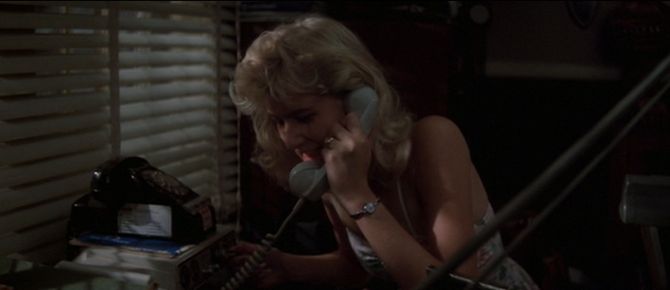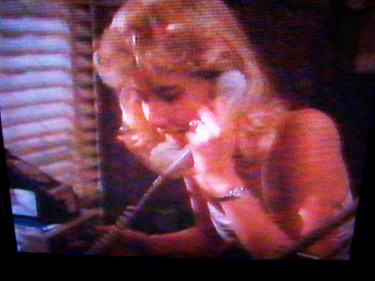 Back to selection
Back to selection
The Blue Velvet Project
Blue Velvet, 47 seconds at a time by Nicholas Rombes
The Blue Velvet Project, #136

Second #6392, 106:32
If you’re of a certain age, you first saw Blue Velvet on VHS (Karl-Lorimar Video) in 1987, in its over-saturated, pan and scan version, which eliminated nearly 40% of the framed image (below).

This is Sandy in her father’s home office, on the phone to the police station, trying desperately to reach her father to safeguard Jeffrey, who is on his way to Dorothy’s apartment. “We don’t know his whereabouts at this time,” the voice tells her from the other end of the line. In the VHS version, Sandy is psychedelic, illuminating the screen with her desire. In her analog, 300×480 resolution, she is somehow more real than her digital, DVD version, which cools off the psycho-drama of the Blue Velvet’s roots in American soap operas.
What’s missing in the VHS pan and scan is the wide-screen darkness that engulfs Sandy. The space around her is empty and dark, and although we might say that each digital iteration (including the latest Blu-ray version, which boasts “a transfer and color correction by Lynch himself”) brings us closer to the true Blue Velvet, what are we truly coming closer to other than ourselves? “The past exists,” Slavoj Žižek has written in The Sublime Object of Ideology, “as it enters into the synchronous net of the signifier—that is, as it is symbolized in the texture of the historical memory—and that is why we are all the time ‘rewriting history’, retroactively giving the elements their symbolic weight by including them in new textures.”
The textures of Blue Velvet—its image resolutions, aspect ratios, pixilations—are, in a sense, the textures of our memories.
Over the period of one full year — three days per week — The Blue Velvet Project will seize a frame every 47 seconds of David Lynch’s classic to explore. These posts will run until second 7,200 in August 2012. For a complete archive of the project, click here. And here is the introduction to the project.
